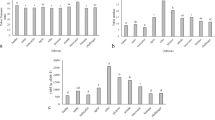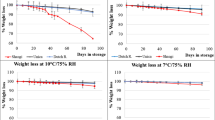Abstract
A study was conducted to investigate the influence of genotype, growing environment and storage period on postharvest quality of seven released potato cultivars grown at Adet (2240 masl), Chilga (2270 masl), and Dabat (2620 masl), northwest Ethiopia in 2006. Cured tubers of each cultivar from each location were stored at ambient conditions for 8 weeks in a locally constructed dark room in Adet, the location with the highest temperatures. The quality of the tubers and the crisps prepared from them was evaluated at weekly intervals. Tubers from cvs Jalenie, Guassa, and Zengena had a high specific gravity (1.088–1.094) and dry matter percentage (26.2–27.1%) when grown in Dabat and Chilga, and a lower specific gravity (1.064–1.072) and dry matter percentage (22.3-22.7%) when grown in Adet. These cultivars produced crisps with a taste value of 8 (like very much) when grown in Chilga and Dabat and of almost 7 (like moderately) when grown in Adet. There was a progressive reduction in specific gravity, dry matter percentage, and taste of crisps with increase in storage time. Cultivars with higher dry matter concentration maintained a better quality than cultivars with a lower dry matter concentration. Across growing locations and cultivars, 57% of the crisps samples were white to cream colored, 33.3% light tan and 9.5% dark tan after 1 week of storage, whereas after 6 weeks of storage none of the cultivars produced white cream colored crisps. It is reasonable to conclude that cvs Jalenie, Guassa, and Zengena can produce tubers with a high dry matter percentage under Chilga and Dabat conditions, from which acceptable crisps can be prepared from tubers stored up to 6 weeks under ambient conditions.

Similar content being viewed by others
References
Akeley RV, Stevenson FJ (1944) The inheritance of dry matter in potatoes. Am Potato J 21:83–89
Amoros W, Espinoza J, Bonierbale M (2000) Assessment of variability for processing potential in advanced potato populations. CIP, Lima
Basker D (1975) Centigrade scale temperature corrections to the specifie gravity of potatoes. Potato Res 18:123–125
Booth A, Lovell P (1972) The effect of pretreatment gibberellic acid on the distribution of photosynthates in intact and disbudded plants of potato (Solanum tuberosum L.). New Phytol 71:795–804
Burton WG, Van Es A, Hartmans KJ (1992) The physics and physiology of storage. In: Harris PM (ed) The potato crop, 2nd edn. Chapman and Hall, London, pp 608–727
Cronk TC, Kuhn GO, McArdle FJ (1974) The influence of stage of maturity, level of nitrogen fertilization and storage on the concentration of solanine in tubers of three potato cultivars. Bull Environ Contam Toxicol 11:163–168
Cunningham CE, Stevenson FJ (1963) Inheritance of factors affecting potato chip color and their association with specific gravity. Am Potato J 40(6):253–265
Dean BB (1994) Managing the potato production system. Food products press, USA, pp 61
FAOSTAT DATA (2004) Agricultural data. Provisional 2003 production indices data. Crop primary. (http://apps.fao.org/default.jsp)
Fitzpatrick TJ, Talley EA, Porter WL, Murphy HJ (1964) Chemical composition of potato. III. Relationship between specific gravity and the nitrogenous constituents. Am Potato J 41(3):75–82
Fitzpatrick TJ, Porter WL, Hoghland GV (1969) Continued studies of the relationship of specific gravity to total solids of potatoes. Am Potato J 46(4):120–127
Fong SF, Redshaw ES (1973) A simple device for determination of potato tubers specific gravity. Am Potato J 50(7):254–257
Hilton RJ (1951) Factors in relation to tuber quality. II. Preliminary trials on bitterness in Netted Gem potatoes. Can J Agri Sci 31:61–68
Hyde RB, Morrison JW (1964) Effect of storage temperature on reducing sugars, pH, and phosphorylase enzyme activity in potato tubers. Am Potato J 41(6):163–168
Irene H, Stuckey R, Tucker E, Sheehan JE (1964) Cooking qualities of Rhode Island potatoes. Am Potato J 41(1):1–13
Iritani WM, Weller LD (1978) Factors influencing reconditioning of Russet Burbank potatoes. Am Potato J 55:425–430
Kabira J, Berga L (2003) Potato processing quality evaluation procedures for research and food industry applications in East and Central Africa. Kenya Agricultural Research Institute, Nairobi, Kenya
Kunkel R, Gregory J, Binkley AM (1951) Mechanical separation of potatoes into specific gravity groups shows promise for the potato chip industry. Am Potato J 28:690–696
Lana EP, Johnson RH, Nelson DC (1970) Variations in specific gravity of potato tubers. Am Potato J 47(1):9–12
Linnemann AR, van Es A, Hartmans KJ (1985) Changes in content of L-ascorbic acid, glucose, fructose, sucrose and total glykoalkaloids in potatoes (cv. Bintje) stored at 7, 16, and 28 °C. Potato Res 28:271–278
Maga JA (1980) Potato glykoalkaloids. Crit Rev Food Sci Nut 12:372–405
Mc Cready RM (1945) Carbohydrate transformation in plants with special reference to the synthesis of sucrose. Ph.D. Thesis presented to the University of California
MSTAT-C (1991) A microcomputer program for design management and analysis of agronomic research experiments. Michigan State University, East Lansing, MI, USA
Salisbury FB, Ross CW (1992) Plant physiology, 4th edn. Wadsworth, California, USA
Stevenson FJ, Akeley RV, Cunningham CE (1964) The potato — its genetic and environmental variability. Amer Potato J 41(2):46–53
Talburt WF, Smith O (1967) Potato processing. AVI, Westport
Watts BM, Ylimaki GL, Jefferies LE, Elias LG (1989) Basic sensory methods for food evaluation. The International Development Research Center, Ottawa, Canada, p 160
William MA, Woodbury GW (1968) Specific gravity dry matter relationship and reducing sugar changes affected by potato variety, production area and storage. Am Potato J 45(4):119–131
Author information
Authors and Affiliations
Corresponding author
Rights and permissions
About this article
Cite this article
Asmamaw, Y., Tekalign, T. & Workneh, T.S. Specific Gravity, Dry Matter Concentration, pH, and Crisp-making Potential of Ethiopian Potato (Solanum tuberosum L.) Cultivars as Influenced by Growing Environment and Length of Storage Under Ambient Conditions. Potato Res. 53, 95–109 (2010). https://doi.org/10.1007/s11540-010-9154-1
Received:
Accepted:
Published:
Issue Date:
DOI: https://doi.org/10.1007/s11540-010-9154-1




